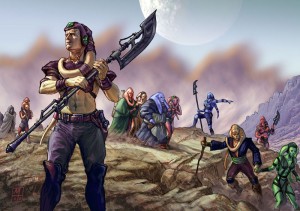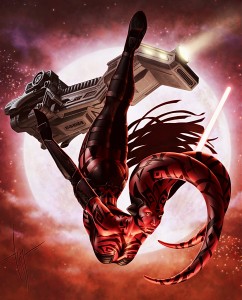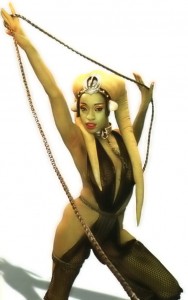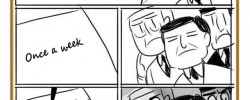TOR Lore: Twi’leks
Twi’leks are one of the most well known alien species in the Star Wars universe, with their tentacles swinging from their heads and their varied skin colors making them easy to recognize among the denizens of the galaxy. Their species has been seen in almost every role in the galaxy, from Jedi to Sith, from senator to slave. They also happen to be, in my opinion, the least humanoid looking species a player can play in The Old Republic, making them popular among those players who are trying to make their character as unique as possible. Today we will take a look at the cultural and physiological aspects unique to this species.
Twi’leks are a humanoid race of aliens hailing from the planet Ryloth, a harsh and unforgiving world. Because of its unusual day-night rotation period, atmospheric conditions on Ryloth’s surface were characterized by turbulent seasons and extremely high winds scouring the surface and sculpting the landscape with unpredictable bursts of heat called heat storms, which could reach 300 degrees centigrade.
A Twi’lek’s most notable features are their varied skin colors and prehensile tentacles that grow from the base of their skulls. The tentacles, called “brain-tails,” “lekku,” “tchun-tchin,” or “head-tails” are advanced organs used for communication and cognitive functions. While Twi’leks are quite capable of communicating in the standard galactic language, Basic, they often prefer their own language, known as Twi’leki, Rylothean, or Ryl, which incorporates subtle movements of their lekku. This language was very hard for other races to understand, and at times Twi’leks could communicate in total secrecy using just their lekku. Their brain-tails are a source of great pride to Twi’leks, especially when confronted by other species. The name “tchun-tchin” actually refers to each lekku, ‘”tchun” being the left lekku and “tchin” the right. In casual conversation Twi’leks would usually refer to their lekku as “tchun” or “tchin.” A Twi’lek’s brain-tails were highly sensitive, and grabbing them forcefully was so painful that it could easily incapacitate almost any Twi’lek. Sometimes, damage to the brain-tails caused lasting damage to the Twi’lek’s brain.
Twi’leks came in many different colors and shades, from bright colors such as yellow and orange to darker shades like brown and gray. Blue is one of the rarest colors of Twi’lek, and these Twi’leks are known as the Rutian Twi’leks. Even more rare are the red-skinned Lethan Twi’leks, a color that was caused by a mutation of the Twi’lek genetic code. Their wide range of colors and slender, attractive bodies made Twi’leks a favorite race for slavers to take and sell on the Galactic Slave Market. In fact, slavery was encouraged and seen as the main form of currency on Ryloth, something that was tolerated by the Galactic Republic. Some saw it as a chance to make money, by kidnapping or selling orphaned children, while others saw slavery as a way of saving children from growing up in Ryloth’s harsh environment. A number of Twi’leks believed that slavery was an efficient way to proliferate their species and preserve their culture, as Twi’leks lacked their own means of inter-planetary travel. Regardless of how it came about, many Twi’leks lived as slaves or entertainers and were considered status symbols, especially the females of rarer skin hues. Their attractive forms and powers of seduction made them skilled dancers, and Twi’leks that managed to escape from captivity usually turned to a life of thievery or prostitution, with both genders making use of their powers of seduction.
Twi’lek society is divided into clans, with each clan having its own city. Each city has its own government, which is led by a five-member head-clan. These five Twi’leks lead the society in all matters until one member of the head-clan dies. At that point, the remaining members of the head-clan would be cast out into the barren landscape on the day-side of the planet, presumably to die, thus allowing the next generation to take over. If the next generation was not yet ready to claim their inherited positions, then a set of regents would be selected to rule until the proper time. Twi’leks were not known for taking staunch stands on many issues. They often preferred to “ride the storm” rather than “defeat it,” as a proverb goes, and avoided taking a stand on any issue. For example, they would often try and maintain ties within both sides during major conflicts to give themselves a chance to survive no matter the conflict’s outcome. Many believe that this mindset was fostered by their harsh life on Ryloth.
Rather than having separate personal and clan names, a Twi’lek would have a single name that combined these two elements. The personal portion of the name would be selected with the clan name in mind, often involving an intentional alteration of the words or a shift in the letters to change the meaning of the name as a whole. This change was meant to symbolize a way of unity. A Twi’lek’s name would also be split into multiple parts if they were exiled as a criminal, as this was considered very dishonoring. An example of a true Twi’lek name would be Nawar’aven. This name would be split into two parts when used outside of the local culture, becoming Nawara Ven. The clan name in this case being Ven, but the name Nawara was selected with the intention of moving the last a into the second half of the name, thus changing the meaning.
With their natural beauty, charm, and rich culture, the Twi’leks are easily a fan favorite among all the different species in the Star Wars Universe. They are not simply dancers or slaves; they are a species that has thrived despite the harshness of their world. They have endured despite the fact that they are often sold into slavery, despite the fact that there are some in the universe who see them as objects only good for displaying as a tribute to their own affluence. They have endured through all these hardships and still thrived, still survived despite it all. In fact, much more space could be dedicated to discussing their culture and habits than I have provided here, but I hope this gives you a glimpse in to what makes this species so beloved and special.
2 Responses to “TOR Lore: Twi’leks”









“Twi’lek SLAVES were often employed<— (Slaves are not EMPLOYED, they are KEPT against their will to be ordered and told what to do to please their master or otherwise get killed) as dancers in various seedy locations"
True enough.